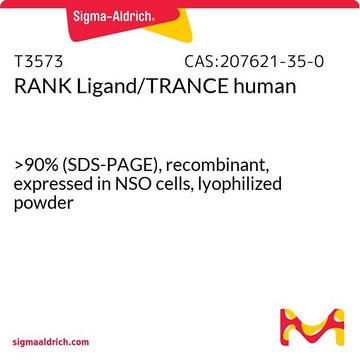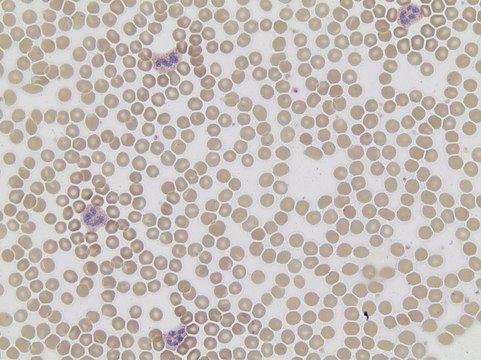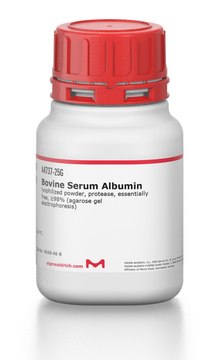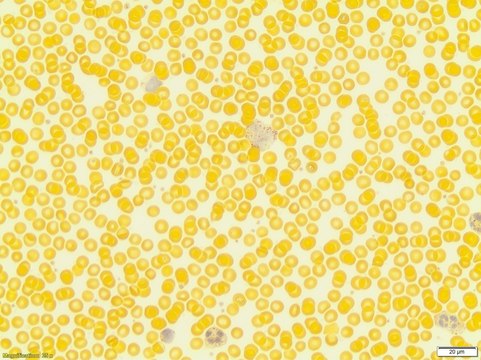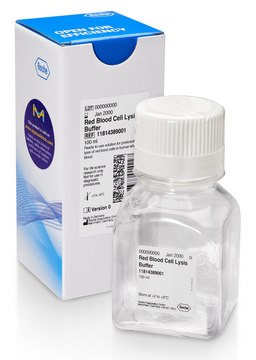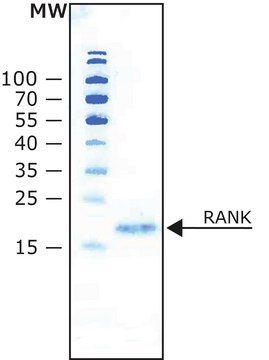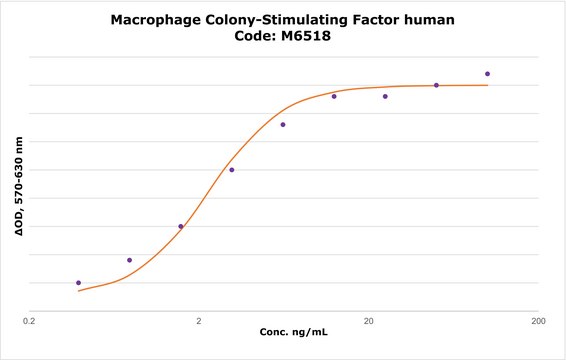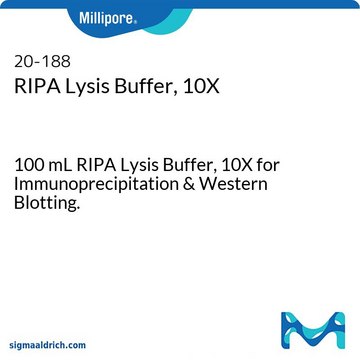GF091
Soluble RANK Ligand (sRANKL) Protein, Recombinant human
The recombinant human sRANKL protein is produced in E. Coli.
Synonym(s):
sRANKL, Soluble Receptor Activator of NF-Kappa B, TNFSF11, OPGL, ODF
Sign Into View Organizational & Contract Pricing
All Photos(1)
About This Item
UNSPSC Code:
12352202
eCl@ss:
32160405
NACRES:
NA.77
Recommended Products
biological source
human
Quality Level
recombinant
expressed in E. coli
Assay
>98% (SDS-PAGE and HPLC)
manufacturer/tradename
Chemicon®
technique(s)
cell culture | mammalian: suitable
impurities
<0.1 ng/μg Endotoxin (1EU/μg)
input
sample type mesenchymal stem cell(s)
NCBI accession no.
UniProt accession no.
shipped in
dry ice
Gene Information
human ... TNFSF11(8600)
General description
Product Source: E. coli
RANKL and RANK are members of the TNF superfamily of ligands and receptors that play an important role in the regulation of specific immunity and bone turnover. RANK (receptor) was originally identified as a dendritic-cell-membrane protein, which by interacting with RANKL augments the ability of dendritic cells to stimulate naïve T-cell proliferation in a mixed lymphocyte reaction, to promote the survival of RANK + T cells, and to regulate T-cell-dependent immune response. RANKL, which is expressed in a variety of cells including osteoblasts, fibroblasts, activated T-cells and bone marrow stromal cells, is also capable of interacting with a decoy receptor called OPG. Binding of soluble OPG to sRANKL inhibits osteoclastogenesis by interrupting the signaling between stromal cells and osteoclastic progenitor cells, thereby leading to excess accumulation of bone and cartilage.
Recombinant human sRANKL produced in E. coli. The protein is a 20.0 kDa polypeptide comprising the TNF homologous region of RANKL (176 amino acid residues).SEQUENCE: MEKAMVDGSW LDLAKRSKLE AQPFAHLTIN ATDIPSGSHK VSLSSWYHDR GWAKISNMTF SNGKLIVNQD GFYYLYANIC FRHHETSGDL ATEYLQLMVY VTKTSIKIPS SHTLMKGGST KYWSGNSEFH FYSINVGGFF KLRSGEEISI EVSNPSLLDP DQDATYFGAF KVRDID
COUNTRY OF ORIGIN: USA
COUNTRY OF ORIGIN: USA
Physical form
Sterile filtered, and then lyophilized from 5 mM sodium phosphate, pH 7.6 + 75 mM NaCl. Reconstitute with distilled water to a concentration of 0.1-1 mg/mL as a stock solution. Solution can then be diluted into other aqueous buffers for immediate use.
Storage and Stability
The lyophilized powder is stable for several weeks at room temperature, but best stored at -20°C for up to one year from date of receipt. Reconstituted stock material can be stored at 2°-8°C for one week, but undiluted aliquots at -20°C are recommended for longer use. Avoid repeated freeze/thaw cycles.
Analysis Note
Specific Activity: Determined by its ability to induce osteoclast formation in RAW264.7 cells using a concentration range of 5.0-10.0 ng/mL.
Legal Information
CHEMICON is a registered trademark of Merck KGaA, Darmstadt, Germany
Disclaimer
Unless otherwise stated in our catalog or other company documentation accompanying the product(s), our products are intended for research use only and are not to be used for any other purpose, which includes but is not limited to, unauthorized commercial uses, in vitro diagnostic uses, ex vivo or in vivo therapeutic uses or any type of consumption or application to humans or animals.
Storage Class Code
11 - Combustible Solids
WGK
WGK 1
Certificates of Analysis (COA)
Search for Certificates of Analysis (COA) by entering the products Lot/Batch Number. Lot and Batch Numbers can be found on a product’s label following the words ‘Lot’ or ‘Batch’.
Already Own This Product?
Find documentation for the products that you have recently purchased in the Document Library.
Junchi Huang et al.
Clinical & experimental metastasis, 39(5), 801-814 (2022-08-16)
Metastasis to bone is the leading cause of death from prostate cancer. Interaction between tumor cells and bone cells can promote progression and influence tumor phenotype. It is known that prostate cancer cells support osteoclast differentiation, and degradation of bone
Our team of scientists has experience in all areas of research including Life Science, Material Science, Chemical Synthesis, Chromatography, Analytical and many others.
Contact Technical Service